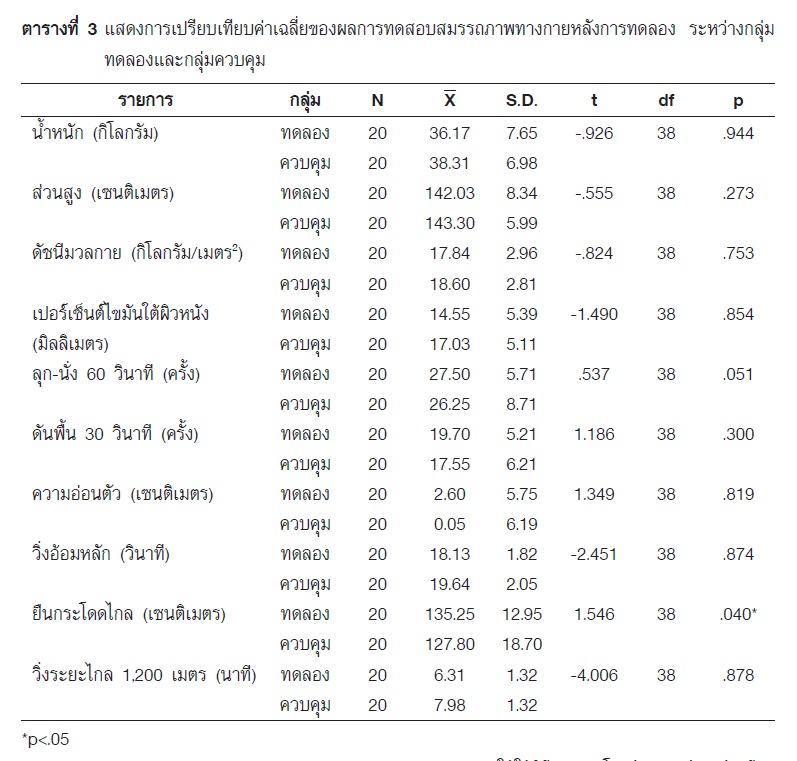EFFECT OF RUBBER JUMPING PROGRAM ON SELECTED PHYSICAL FITNESS MEASURES IN CHILDREN AGED 10-12 YEARS OLD
Main Article Content
Abstract
Purpose : This research aimed to study the effect of rubber jumping programs on physical fitness in children aged 10-12 years.
Methods : A total of 40 children volunteered to participate in this study and were randomly allocated into an experimental group (n=20) and a control group (n=20). The experimental group engaged in a 60-min rubber jumping exercise, 3 days a week for 8 weeks. The control group maintained their regular school activity and received no intervention. Before and after training, the physical fitness battery test was administered. Data were presented as the mean and standard deviation and the differences were compared by using Paired t-test (pretest and posttest) and Independent sample t-test (between groups).
Results :
1) For the experimental group, the average body weight, height, sit-ups, push-ups, zig-zag run, standing long jump and distance running (1,200 m) were statistically different between pretest (p<.05) and posttest. On the other hand, there were no significant differences in the average of body mass index (BMI), skinfold thickness and flexibility.
2) For the control group, the average of body weight, height, BMI, sit-ups and push-ups were statistical different (p<.05) between pretest and posttest. In contrast, there were no differences in the average skinfold thickness, flexibility, zig-zag run, standing long jump and distance running.
3) After 8 weeks of training, there was only a significant difference (p<.05) in standing long jump between groups. However, no significant differences were observed in other variables.
Conclusion : This research demonstrated the beneficial effect of rubber jumping program on physical fitness components especially a standing long jump in children aged 10-12 years.
Article Details

This work is licensed under a Creative Commons Attribution-NonCommercial-NoDerivatives 4.0 International License.
References
Boobpachart D., Napthuetrong U., Boobpachart W., Kuasiri C. (2018). The effect of physical activity onhealth-related physical fitness of students in the laboratory school of Ubon Ratchathani Rajabhat University. Ubon Ratchathani Rajabhat University Journal for Public Health research, 7(2), 70-77.
Gomaratut C. (2006). Thai Traditional Sports: Northern Region. Bangkok: Satapornbooks. Kerdthempoom A. (2013). Textbook for learning mechanical skills: To applied teaching physical education and sport. Bangkok: PR. Printing House Limited Partnership.
Patummanee P., Gomaratut C. (2011). Effects of physical training program with thai traditional plays on intelligence quotient, emotional quotient and physical & play quotient of the primary school male students between the ages of 10-12 years old. Journal of Sports Science and Health. 12(1), 65-78.
Ruengpanyawut P. (2013). Effects of physical education learning management using Thai Folk Games on health-related physical fitness of elementary school students. Master’s Thesis, Faculty of Education, Chulalongkorn University. Bangkok.
Samahito S, et al. (2012). Test and standard of physical fitness for Thai children aged 7-18 years. Sport Science Bureau, Department Of Physical Education, Ministry of Tourism and Sports. Sampachanya. Bangkok.
Sanewong A., Kanjanasorn W. (2017). The effect of applied thai traditional play on physical fitness and body mass index in overweight students, demonstration school of Udonthani Rajabhat University. Journal of education graduate studies research, Khon Kaen University, 11(2), 265-274.
Silamad T. (2012). Principles of sports training for sports trainers. Publisher of Chulalongkorn University. Bangkok.
Srisuk S., Karawa J., Khongsebsor W., Hongsamanut S., Wisetsung S., Premsri N. (2018). Effects of physical activity program on health-related physical fitness among grade 4-6 students in Ban-Don-Yanang School, Nakhon Phanom Province. Nakhon Phanom University Journal, 8(3), 1-8.
Wongputthichai P., Suttitum T., Manimanakor A., Kittinon K. (2017). The Effect of applied plyometric training program on muscle strength and muscle power in male Thai Boxing athletes. Srinagarind Medical Journal, 32(2), 163-171.


